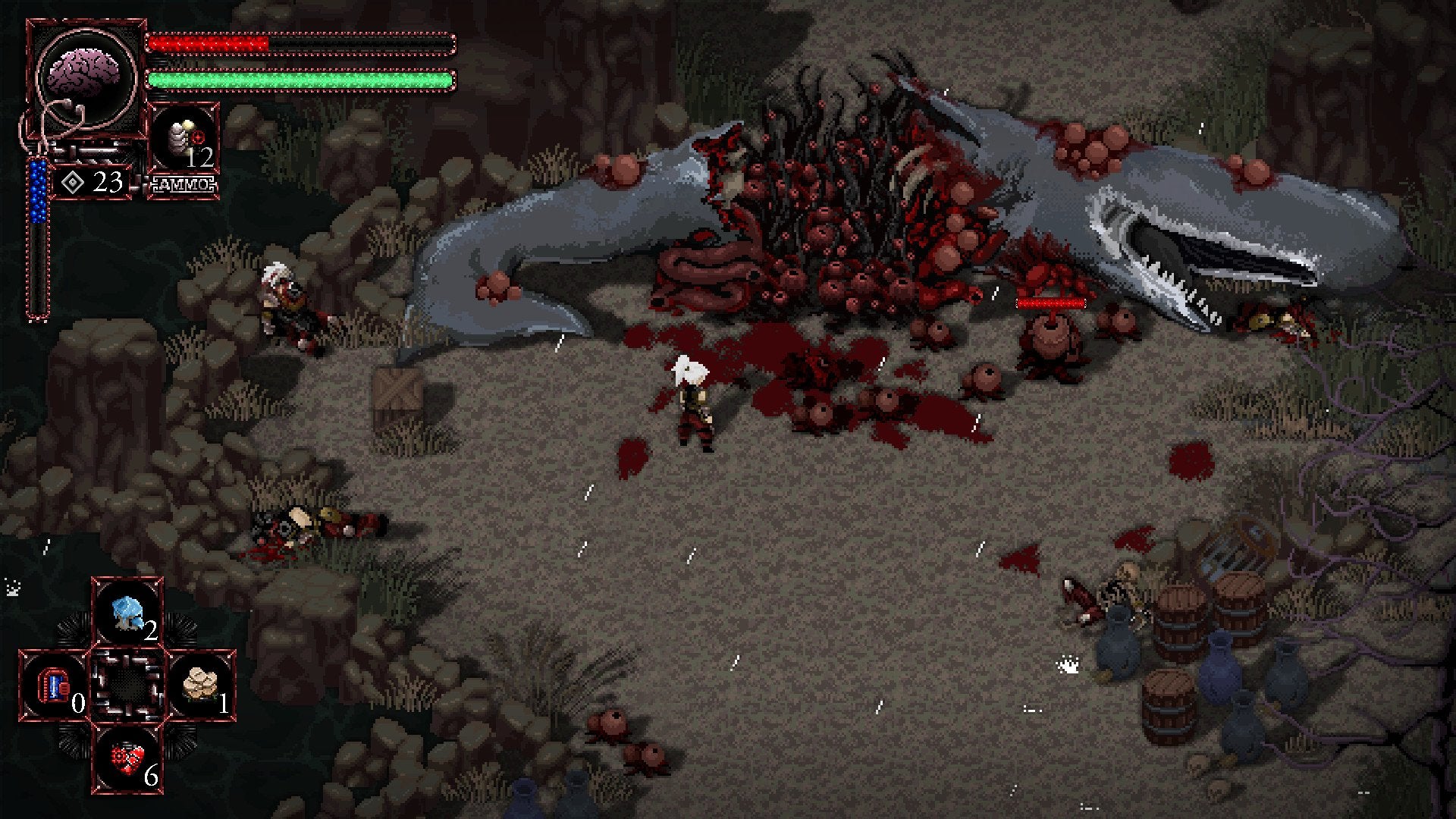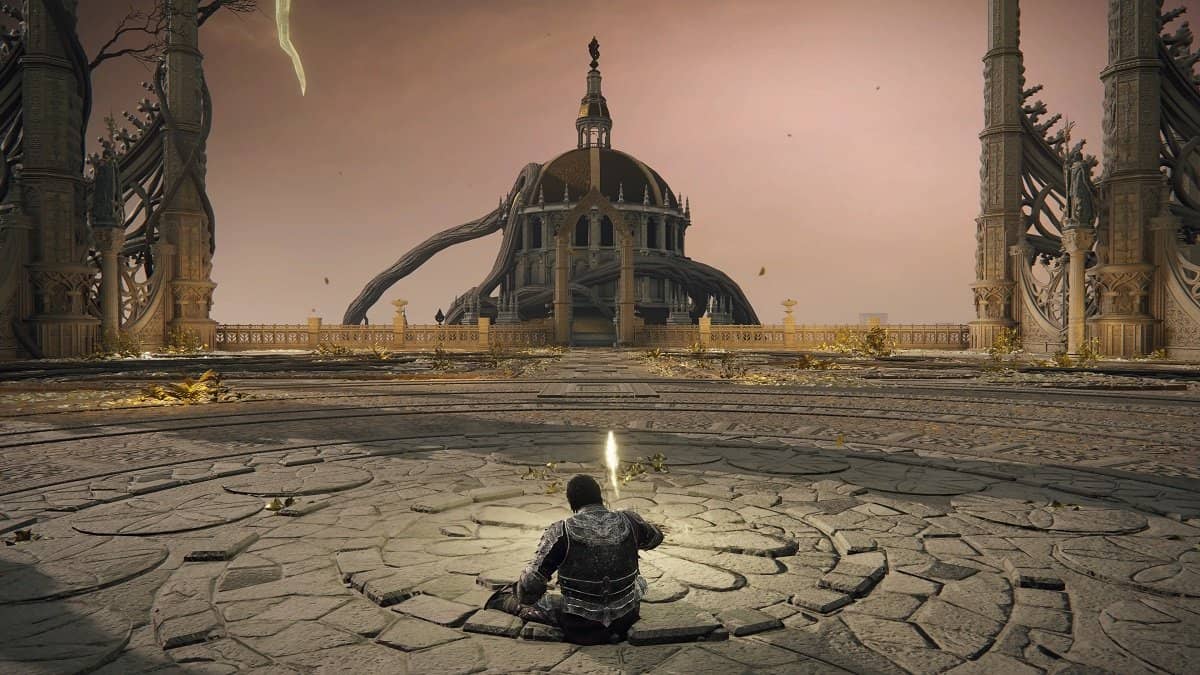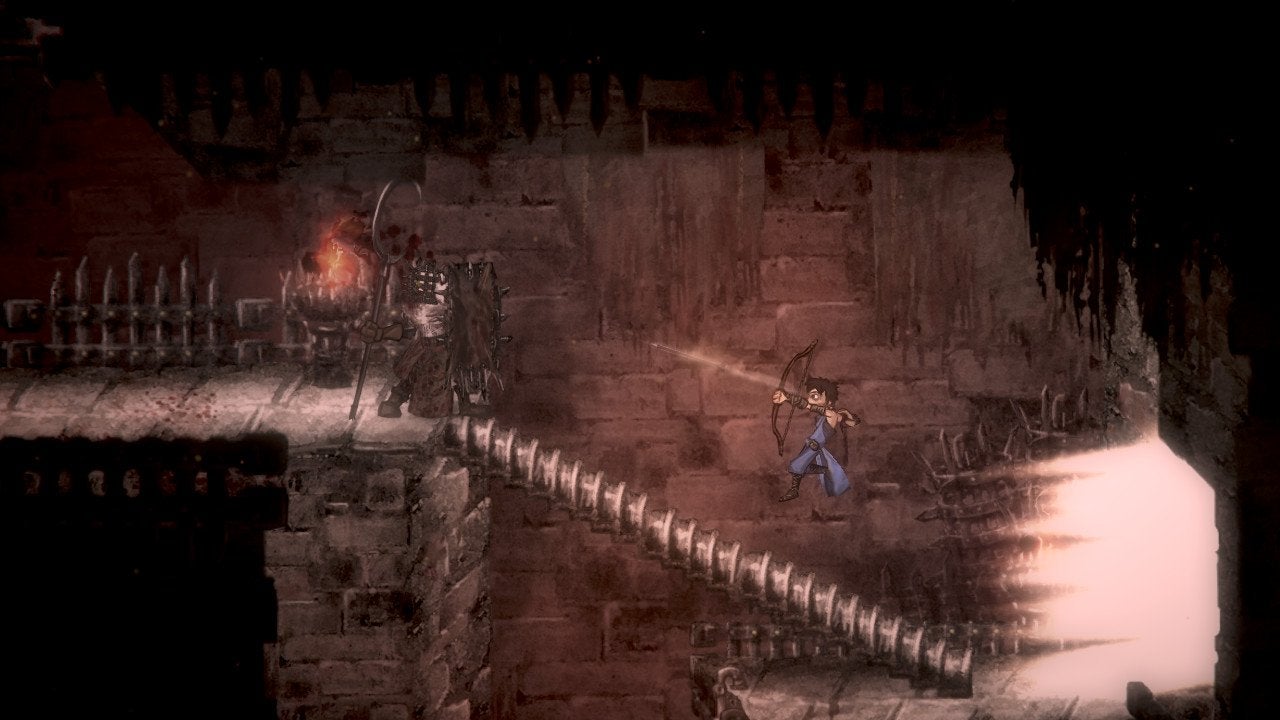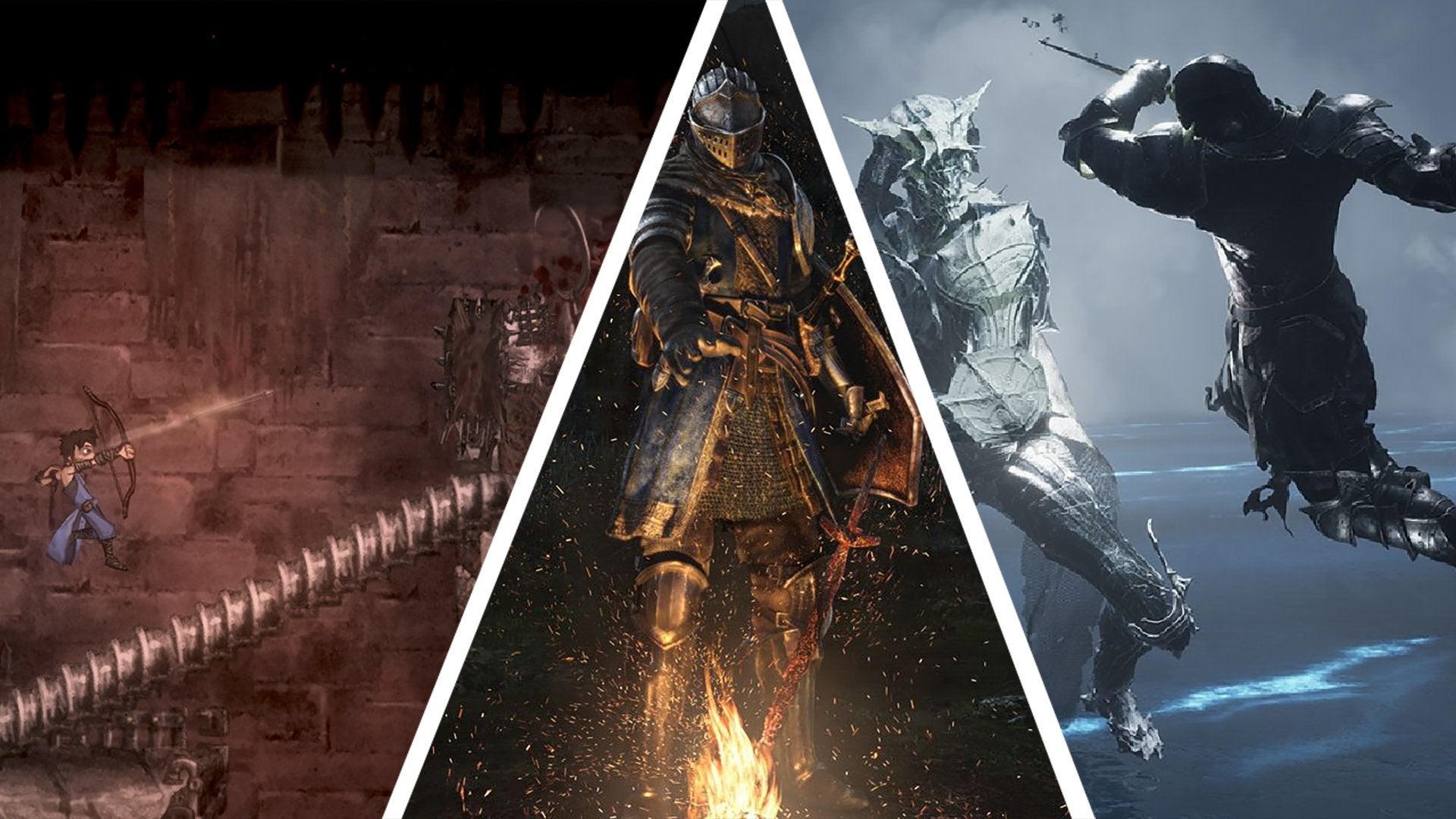![]() Key Takeaway
Key Takeaway
Soulslike games are those that are similar to Demon’s Souls and the Dark Souls trilogy. Here are the most important elements; a true Soulslike should have at least a few of these:
- Balanced Difficulty
- ARPG Qualities
- Melee Combat-Oriented Gameplay
- Combat Resource Management
- Comfy Checkpoints
- Losing Currency Upon Death
- Deep Lore
- Third-Person Exploration
- Lots of Character Creation and Build Options
Soulslike games bear similarities to their namesake: the Dark Souls trilogy. Some of the features that made the aforementioned titles modern-day classics need to be present. From conserving stamina to precisely timing attacks and more—there’s a lot that goes into making a game resemble FromSoftware’s revolutionary series.
Table Of Contents
The Features That Make a Game a Soulslike

Simply dubbing a game a “Soulslike” because it has challenging gameplay is the wrong way to use this term. There needs to be multiple elements that harken back to the core concepts in the Dark Souls trilogy (and its forebearer Demon’s Souls) before a title can be accurately entered into the Soulslike genre.
Before going on, we should mention that this genre is sometimes spelled “Souls-like.” With that said, the dash doesn’t matter much—it’s a matter of preference.
On top of that, not all of the following qualities need to be exhibited by a game for it to be called a Soulslike. However, there needs to be at least a few found together!
Balanced Difficulty
Let’s begin with the most debated element of Soulslike games. Yes, the Souls games by FromSoftware are initially pretty hard for the uninitiated. Although this is the case, these games are not unfair by any means.
In fact, the refined balance of challenges players face in Soulslike games is a defining trait. If a game is too easy, it is not a Soulslike—and the same is true if said game is unreasonably difficult.

Soulslike games punish players for being reckless or careless but reward them for preparation and exhibiting great combat skills.
For a frame of reference: games where you can spam basic attacks (and do nothing else) to defeat bosses are too easy. On the opposite side of this conceptual coin: a game that features too many enemies that can kill you in a single hit is too hard.
ARPG Qualities
ARPG stands for Action Role-Playing Game. Such titles involve taking the role of a character (potentially an original character created by the player).
The “action” part comes in to identify that these games are not turn-based RPGs. Instead, ARPGs feature real-time combat where you must act and react to the environment at any given second—all true Soulslikes fall into this category.

Furthermore, classic RPG elements must be present, such as stats for various combat parameters (strength, intelligence, etc.), designated health values (HP), leveling up by gaining some form of currency or experience, and more.
There are no turn-based Soulslikes. All of the Dark Souls games are ARPGs, so the genre named after them needs to be the same. This is one of the most important factors that determine whether or not a game is a Soulslike.
Melee Combat-Oriented Gameplay
Another key component that made the Souls games stand out is their focus on precise combat mechanics. This means avoiding damage from enemy attacks while also choosing the right times to counterattack.
There are usually many ways of getting out of harm’s way, such as parrying, dodging, and blocking; these three techniques are usually featured in Soulslike games.

In a bit more depth, attacking after such evasive maneuvers appears frequently in Soulslikes. For example, attacking after a successful parry lets you perform a riposte. Similarly, dodging and getting behind your foe allows you to backstab them for huge damage in many cases.
The focus on timing is vital for victory in this genre. To learn the proper timing to defeat adversaries, you need to be patient and understand your enemy; observe their movements, and anticipate what they’ll do next. This leads to slower and more methodical combat as opposed to action games that usually prioritize speed over strategy.
Some games focus on ranged weapons, and they can be Soulslikes. In such cases, said games need to concentrate on the same factors mentioned above but apply them to the gunplay in-game. We need to clarify that titles involving guns don’t often get classified as Soulslikes. Games like Bloodborne and Remnant: From the Ashes are a couple of noteworthy examples.
Combat Resource Management
Besides in-the-moment tactics, many Soulslike games require you to consider regenerating resources, such as stamina, healing items, and more. The one most people think of immediately is the aforementioned stamina resource—which usually is represented by a green bar below the (typically) red health bar.
When players use certain combat actions, such as attacking, blocking, and dodging, their stamina is decreased. If sustained actions are continuously used, your stamina bar can become empty, which would leave you unable to act: a vulnerable and undesirable position. As such, you need to constantly gauge how full your stamina meter is to avoid leaving yourself open to attacks.

This extends to other gameplay elements as well, like how spellcasters need to keep track of their mana (focus, magic, etc.) meter. More often than not, this type of combat resource is displayed near the health and stamina bars and is represented by a blue meter.
Let’s not forget consumables that return after resting! In the Dark Souls games, the most memorable are the Estus Flasks. You use these to restore health if you are hurt. However, whenever you rest at a bonfire, all of your flasks are refilled. This allows you some room for error if you poorly time a dodge or parry but you can’t use these as a crutch to get through the entire game due to their limited quantity.
Comfy Checkpoints
Speaking of bonfires—they revolutionized the checkpoint system in modern ARPGs. Bonfires, and their equivalents in non-Souls games, are a reimagining of save points that are commonly used in Soulslike games. They represent a place where you can rest and plan in an area free from danger.
Physical save points like these have positive mental benefits that menu-based saving options lack. The former shows your character relaxing, which is contrasted to your arduous journey everywhere else in-game. The reprieve from death and destruction ticks a box in your brain that is deeply satisfying.

Our primal instincts tell us to fear the dark and that light means safety. The bonfire mechanic plays on this sentiment to great effect. If you die after leaving such a save point, you’ll return there so that you can try again. This leads to our next point…
Losing Currency Upon Death
In most Soulslike games, the penalty for dying is that you lose whatever currency you have on you at the time. After such untimely demises, you’ll respawn at the nearest save point. This encourages you to not only avoid death due to the consequences but also to save often to prevent more significant losses of currency.
However, such losses aren’t initially permanent. If you make it back to the place you last died, you can recover what you lost. With that said, if you die again before recovering your goods, they’ll be gone forever.
Such features differ from game to game—sometimes being a boon with some sort of trade-off. More often than not, however, dying is a bad thing.

While stressful, this once more emphasizes the importance of planning, frequent saving, using currency instead of hoarding it, and, most importantly, improving your combat skills so that you die less often. In other words, get good!
Deep Lore
Worldbuilding is incredibly important in all adventure games. However, Soulslike games do this in a unique way: by deliberately telling players as little as possible about the story and its main characters.
Instead of a straightforward narrative, many Soulslikes tend to deliver the finer points of their story through item descriptions, dialogue with bosses and NPCs, as well as in other—more cryptic—manners.

While initially seeming counterintuitive, this type of storytelling accomplishes two important tasks: it avoids bogging players down with lore if they don’t care about it and it encourages players who are interested in lore to seek out every item, boss, and NPC to get a fuller picture of the tale.
The latter trait can greatly lengthen playtime and offer you another layer of satisfaction for exploring. Increasingly curious gamers will also speculate the more mysterious aspects and discuss them with others—further growing the interest in a game in an organic and novel way. For proof, look at all those Dark Souls lore videos on YouTube.
Third-Person Exploration
In regards to deep lore tempting players into exploring, adventuring deeper and farther into each area is crucial for Soulslike gameplay. In well-made ARPGs, you’re given the freedom to investigate interesting locales, and Soulslikes take this to a whole new level. You’re rewarded for thorough exploration by finding rare items, hidden bosses, and other fun gameplay elements.
With that said, the perspective matters quite a lot here. Soulslike games are seldom in first-person. The majority of them have their cameras fixed outside the player’s character so that you can see immediately around yourself. This is true both in 2D and 3D Soulslikes. On that note, let’s delve into the dimensional debate.
2D Versus 3D Soulslikes
Lots of gamers claim that Soulslikes can only be in 3D. However, this is not necessarily the case. The dimensions in which a game is rendered don’t matter nearly as much as other elements. A 2D game can still have ever-important Soulslike features such as ARPG qualities, combat resource management, and comfy checkpoints.
Adding to the confusion is that there are tons of titles in the Metroidvania genre that get lumped into the Soulslike category. There is definitely some overlap between the two genres. However, Metroidvanias differ a bit in that most of them are 2D, they often lack stamina as a resource, and usually task the player with quicker and less strategic actions.

Once more: there is some overlap. A game can be both a Metroidvania and a Soulslike. Instead of thinking of them separately, consider Metroidvania to be the parent genre and Soulslike to be the child.
The latter would not exist without the former, as the Dark Souls trilogy (and its predecessor, Demon’s Souls) owe a lot of their mechanics to early Metroid and Castlevania games pioneering them.
Circling back around: Soulslikes can certainly be 2D—but they are most commonly 3D.
Lots of Character Creation and Build Options
Well-made Soulslike games also feature a high degree of customization for both aesthetics and combat preferences. Most often, they let you create the craziest character you can think of (in terms of appearance). What’s more, you’re allowed to use even the silliest weapons to hack, slash, and club your way through swathes of enemies.
Want to smack other players to death with a ladle? Well, you can do that! Or, instead, you can dual-wield the most unwieldy masses of metal to crush foes into a bloody paste—albeit at the expense of tearing your character’s rotator cuffs to shreds.

Such traits add tons of replay value to Soulslike games. This is compounded by the (usually) huge arsenal programmed into each game. Variety is the spice of life, right?
The freedom to experiment and joke around adds comedic value to what should usually be a melancholy journey. On top of that, you can push the limits of what is even possible in-game. As a result, you have tons of people trying the wackiest challenge runs they can think of years after a game gets released.
While most prominent in the Dark Souls trilogy, similar feats crop up in other properties as well.
A Cautionary Tale About Using a Game’s Title as a Genre Template
Before you begin rejecting games from your wishlist because they don’t meet the criteria outlined in this article, remember that Soulslike games aren’t the only good ARPGs out there. While they revolutionized the genre—and much of the video game industry—they are not the be-all, end-all genre.
In addition, there aren’t really any games that are exactly like Demon’s Souls and the Dark Souls trilogy. In fact, they aren’t the same as each other either! There are lots of differences that make the former differ from the latter and even key components that vary within the latter trilogy’s entries.
Using the Soulslike genre to easily classify games is fine. However, don’t use this term to denounce an ARPG because it doesn’t have a stamina bar or parrying mechanics.
If you’re a game developer who loves Soulslikes, you owe it to yourself to avoid emulating the original Souls games exactly. Be different; innovate and improve on the genre you adore! Sameness leads to stagnation.
Why do you think Miyazaki and the FromSoftware team aren’t making any more true Souls games? It’s because they accomplished what they set out to do. They now want to look to the future to make even better titles. Sure, they’re keeping a lot of the elements that made their earlier games great, but they are also coming up with new and exciting features.
List of the Best Soulslike Games
In no particular order, here are some of the best Soulslike games out there:
- Demon’s Souls
- Dark Souls
- Dark Souls 2
- Dark Souls 3
- Bloodborne
- Elden Ring
- Hollow Knight
- Dead Cells
- Star Wars Jedi: Fallen Order
- Lies of P
- Remnant: From the Ashes
- Blasphemous
- Blasphemous 2
- Salt and Sanctuary
- Nioh
- Nioh 2
- Tunic
- ENDER LILIES: Quietus of the Knights
- Mortal Shell
- Going Under
- Morbid: The Seven Acolytes
- The Last Faith
When in doubt, parry and roll about! If you’re a big fan of Soulslike games and aren’t sure what title to tackle next, we recommend Elden Ring and Hollow Knight, as we’re experts in those games. We’ve got all the tips and tricks to help you through them if you get stuck. More importantly, they’re fantastically fun! Keep your head down and your eyes up, warrior; you never know what’s around the next dimly lit corner.


